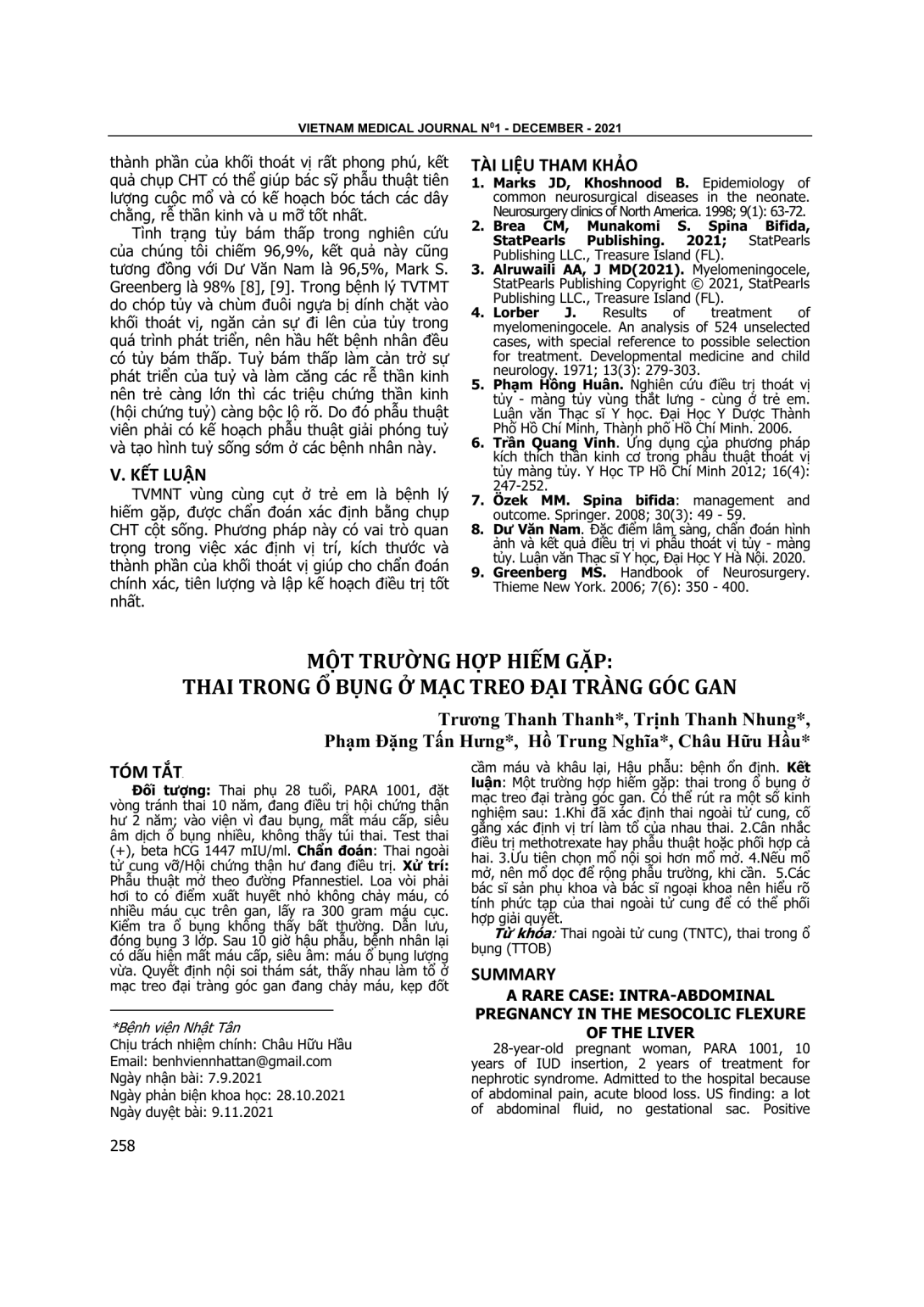
Thai phụ 28 tuổi, PARA 1001, đặt vòng tránh thai 10 năm, đang điều trị hội chứng thận hư 2 năm; vào viện vì đau bụng, mất máu cấp, siêu âm dịch ổ bụng nhiều, không thấy túi thai. Test thai (+), beta hCG 1447 mIU/ml. Chẩn đoán: Thai ngoài tử cung vỡ/Hội chứng thận hư đang điều trị. Xử trí: Phẫu thuật mở theo đường Pfannestiel. Loa vòi phải hơi to có điểm xuất huyết nhỏ không chảy máu, có nhiều máu cục trên gan, lấy ra 300 gram máu cục. Kiểm tra ổ bụng không thấy bất thường. Dẫn lưu, đóng bụng 3 lớp. Sau 10 giờ hậu phẫu, bệnh nhân lại có dấu hiện mất máu cấp, siêu âm: máu ổ bụng lượng vừa. Quyết định nội soi thám sát, thấy nhau làm tổ ở mạc treo đại tràng góc gan đang chảy máu, kẹp đốt cầm máu và khâu lại, Hậu phẫu: bệnh ổn định. Kết luận: Một trường hợp hiếm gặp: thai trong ổ bụng ở mạc treo đại tràng góc gan. Có thể rút ra một số kinh nghiệm sau: 1.Khi đã xác định thai ngoài tử cung, cố gắng xác định vị trí làm tổ của nhau thai. 2.Cân nhắc điều trị methotrexate hay phẫu thuật hoặc phối hợp cả hai. 3.Ưu tiên chọn mổ nội soi hơn mổ mở. 4.Nếu mổ mở, nên mổ dọc để rộng phẫu trường, khi cần. 5.Các bác sĩ sản phụ khoa và bác sĩ ngoại khoa nên hiểu rõ tính phức tạp của thai ngoài tử cung để có thể phối hợp giải quyết.
28-year-old pregnant woman, PARA 1001, 10 years of IUD insertion, 2 years of treatment for nephrotic syndrome. Admitted to the hospital because of abdominal pain, acute blood loss. US finding: a lot of abdominal fluid, no gestational sac. Positive pregnancy test, beta hCG 1447 mIU/ml. Diagnosis: Ruptured ectopic pregnancy/Nephrotic syndrome being treated. Treatment: Open surgery with Pfannestiel incision: Right fimbriae must be slightly enlarged with small bleeding points without bleeding, there were many blood clots on the liver, 300 grams of blood clots were removed. Exploring the abdominal cavity wasn't abnormal. Drained and closed the abdomen in 3 layers. After 10 hours of surgery, the patient continued to show signs of acute blood loss, abdominal US finding had moderate free blood. Decided to have laparoscopic surgery to see that the placenta implanted in the mesocolic flexure of the liver was bleeding. We burned and clamped it to stop the bleeding here and sutured the abdomen. Postoperatively, the patient was fine. Conclusion: We draw some experiences as follows: 1. Once the ectopic pregnancy has been identified, try to determine the location of the placenta's implantation. 2. Consider methotrexate or surgery, or a combination of both. 3. Prioritize choosing endoscopic surgery over open surgery. 4. If open surgery, should be operated longitudinally to widen the surgical field, when needed. 5. Obstetrician-Gynecologists and general surgeons should understand the complexities of ectopic pregnancy so that they can sometimes work together to manage them.
- Đăng nhập để gửi ý kiến
